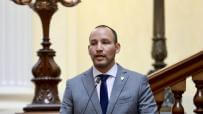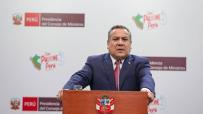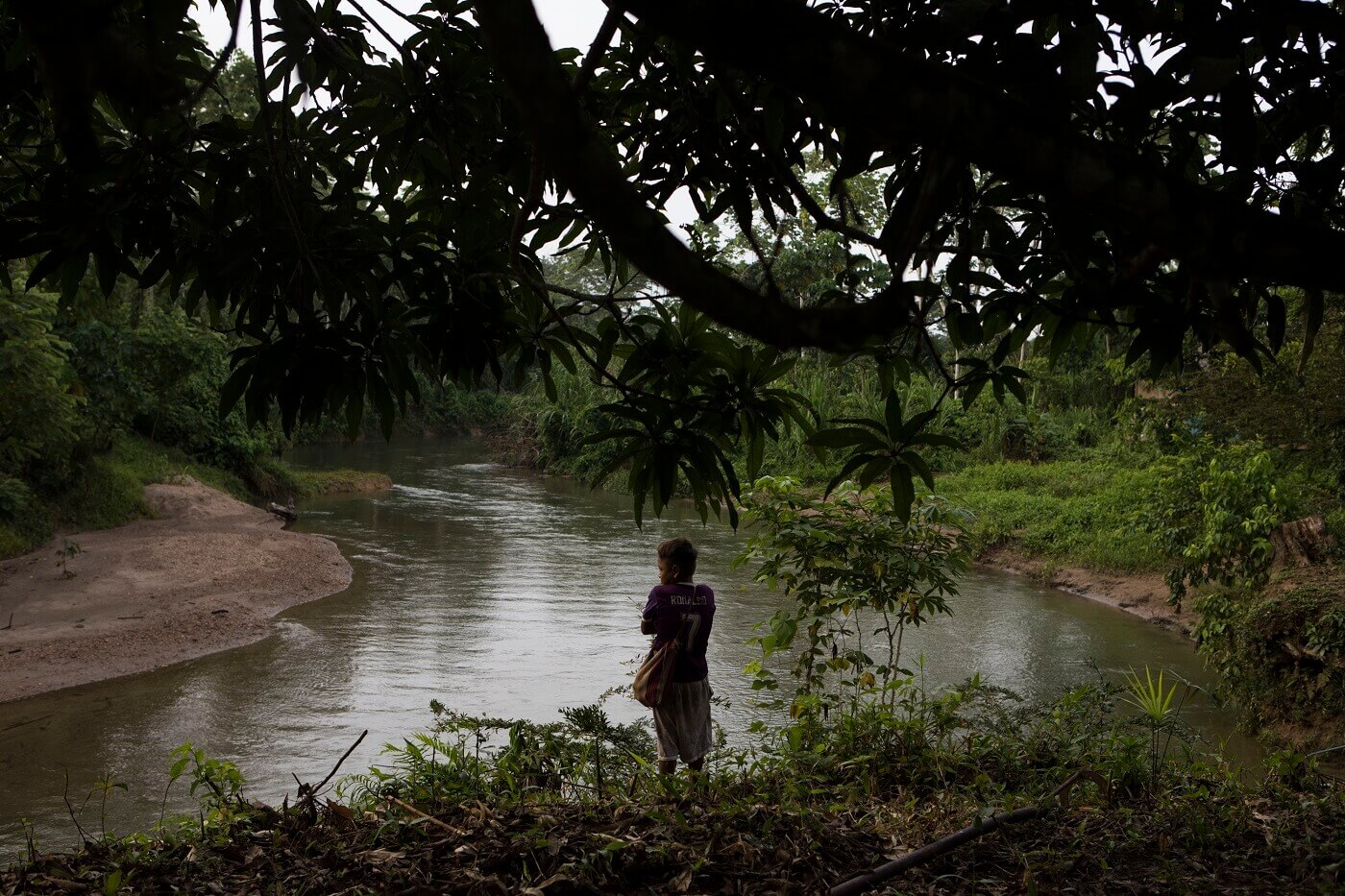
The Asheninka community of Diobamba is located one hour by flight from the Peruvian capital to the city of Pucallpa in the Amazon region of Ucayali, then another 45 minutes by plane and four hours by boat. Since 2017, this locality and its little more than 260 inhabitants have been waiting for the extension of its indigenous territory by 165 hectares. Leaders indicate that if this process is approved, the families will be able to conduct forestry activities and increase their incomes, which today come mainly from the sale of cocoa and other fruits in the area. However, with the arrival of the pandemic and the beginning of criminal investigations against former authorities of the Regional Agriculture Directorate of this region (DRAU), the process that began in 2018 stopped.
North of Peru, also in the Amazon, but in Colombia, Nazareth Cabrera, an indigenous leader in the Araracuara sector, where communities are also trying to empower themselves and protect their territories with the help of the State, says that although he does not know the exact figures, deforestation has increased. “When I come by plane, I can see that near Caqueta or San José del Guaviare, the forests are ravaged. And I wonder: In this remoteness, from where they come, where they deforest from. It is a lie that the jungle remains intact. That is a lie.”
The expansion of the territory of the Diobamba community in Peru, and the actions to protect forests in Colombia, are two of the several activities included in the commitments made under the Joint Declaration of Intent (JDI). This is an agreement entered in 2014 among the governments of Norway, Germany, and Peru; and in 2015 between Norway, Germany, the United Kingdom and Colombia, with the aim of reducing greenhouse gas emissions from deforestation. It is at this point where indigenous territories have a fundamental role, as these are the areas where forests are best preserved.
In recent years, in the face of the climate crisis, the South American Amazon, which is shared by Bolivia, Peru, Colombia, Brazil and Venezuela have received millionaire funding to contain forest destruction.
The purpose of these funds, including resources such as those of the JDI, is to avoid the worst impacts of global warming. In the Paris Agreement and other international treaties, the richest countries (responsible for the world's temperature rise) agreed to contribute money to the developing world to transform energy, industrial, and agricultural systems and protect the most vulnerable communities. But with limited funds which are partially delivered at the global level, efficient use of each project is vital.
Peru and Colombia are two of the countries with the most climate financing agreements in place. OjoPúblico analyzed the uses of the funds which are part of the JDI agreement with Norway, Germany and the United Kingdom, reviewed resource management reports in Peru and Colombia, requested reporting of expenditures and enforcement through the Transparency Law, and interviewed indigenous leaders. experts and former officials linked to this international agreement in both countries to understand how and what it is invested in and the impact on the communities.
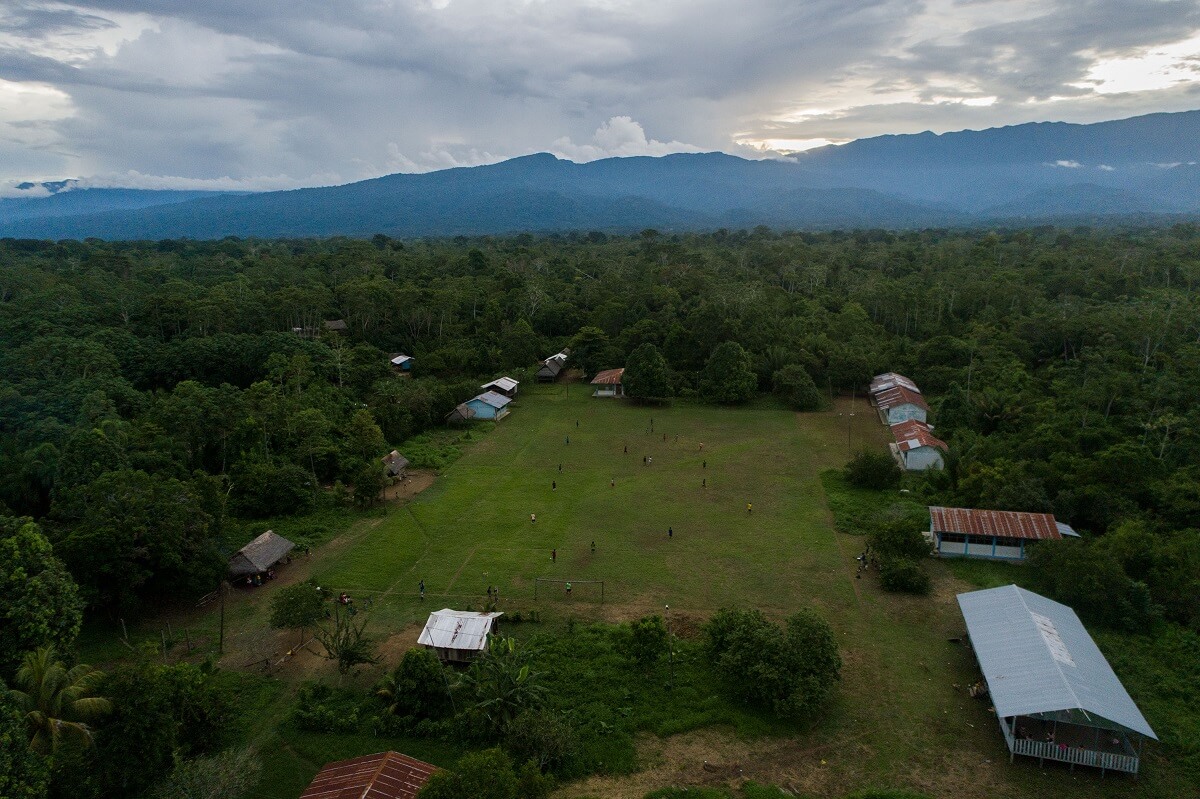
IN THE WAIT. Since 2018, the Asheninka community of Diobamba (Ucayali) has looked forward to the approval for the expansion of 165 hectares of territory.
Photo: OjoPúblico / Marco Garro.
In Peru, five years after implementing the agreement, the goal of titling five million hectares of indigenous communities by 2020 has advanced by less than 40%. However, not all of this delay can be attributed to complications related to the COVID-19 crisis. According to a report by the Ministry of the Environment itself, before the pandemic, there was already evidence of non-compliance with the goal: in 2019, 84% less of the titling was achieved, compared to 2018.
Along with these agreements ,different scientific and civil society publications have underscored the role of titled communities in forest conservation and their relevance in reducing carbon dioxide (CO2) emissions associated with deforestation. In other words, the activities where they have been considered in the JDI are vital to meet the objectives related to the mitigation of the climate crisis, including the macro-goals of the Paris Agreement.
Indigenous communities seem to be a logical investment in this financing. Their communities care for 80% of the planet biodiversity and bring enormous benefits in conservation, carbon capture, and resilience. However, in the last decade, communities in countries with tropical forests have received only 1% of funds for climate and biodiversity protection, according to the most recent Rainforest Foundation Norway study.
The world's attention seems to be moving toward this void in conservation financing. During the World Summit of High-Level Leaders at the Glasgow Climate Conference (COP 26), the governments of the United Kingdom, Norway, Germany, USA, the Netherlands and 17 other US donors pledged to support indigenous peoples with EUR 1,470 million from now until 2025, for their proven role in preventing deforestation that fuels climate change.
Facing the COP 26 announcements, the Coordinator of Indigenous Organizations of the Amazon River Basin (COICA) and its members, in the nine countries of the Amazon Basin, released a statement calling on communities to manage and coordinate direct financing mechanisms, to make sure funds reach those “who inhabit and defend territories” as “key actors with the ability to offer viable and concrete solutions for nature protection and climate change mitigation”
.
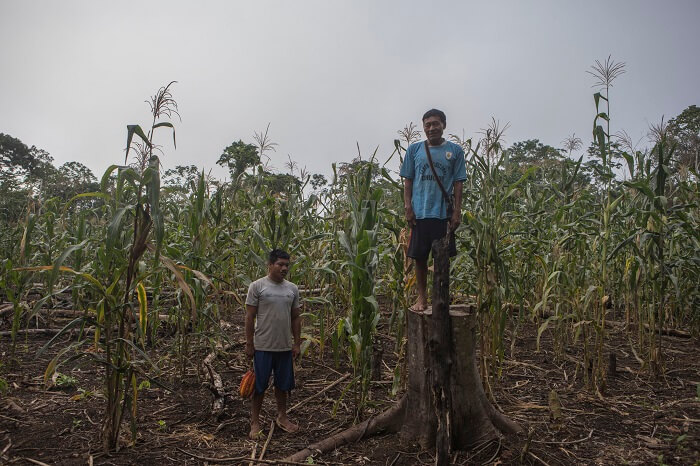
ACTIVITIES. The members of the Diobamba community are mostly engaged in agriculture of products such as maize, bananas and cocoa.
Photo: OjoPúblico / Marco Garro.
The new amounts, labeled “historical” by politicians attending the COP, have been announced years after the commitments made in the JDI by Peru and Colombia with Norway, Germany, and the United Kingdom, and point to the same objectives established at least five years ago. But what progress was made with the implementation of these international funds and what is the role of indigenous peoples?
In Peru, the delays in meeting the objectives, as detailed in this publication, are due to the arrival of Covid-19 but also to the management of the public officials. They are even investigated for illegal activities such as land trafficking or delay the official approval and registration of the titles in favor of indigenous peoples of the Amazon, who in some cases have no resources to move to the capital of the regions and follow up on their processes.
In Amazonian regions such as Ucayali, which last year had the most forest loss, no community has been titled—as part of the JDI—since 2018. This situation has prevented reaching the goal of reducing by half the forest area (estimated at 11 million hectares, five of which correspond to indigenous community titling) without a territorial category assigned to it prior to the international agreement.
Meanwhile, in Colombia the trend was reversed, and more than 144 thousand hectares of forest were lost, twice as much as the previous year. This happened although there was a proven decline in deforestation between 2013 and 2016, which generated a payment for results financing to the EMN Vision Amazon Program in 2017.
At the same time, in 2018, the National Indigenous Organization (ONIC) released a report showing inconsistencies in at least five milestones (noted as advanced or completed by the Ministry of the Environment), reporting the participation or benefit of indigenous communities, something the ONIC is questioning. In 2020, the entity again reported “a lag in guaranteeing the legal security of ancestral territories” and claimed that there were still “important processes for guaranteeing indigenous rights expected progress. Some of them were the policy of protecting colonial resguardos (landholdings), the ethnic approach to payment for environmental services (PES) or the creation of the Indigenous Environmental Consultation Tables”.
Both Vision Amazonia and the Colombia Sostenible Fund, implementing the agreement (although not exclusively), highlight the relevance of the participation of ethnic groups in forest protection, and prioritize capacity-building programs for the communities involved, stating that all measures, from empowerment to direct actions in the environment, contribute to low emissions. However, the approval of a project proposed by the Colombia Sostenible Fund for this purpose took more than three years.
Peru: titling and extensions not approved
Arriving in Diobamba, as a team of OjoPúblico did in late November 2020, a large football field welcomes visitors to the community center. A few meters from the point where a sporting event was held, surrounded by plantain, camu camu and cacao plantations, the Asheninka communal leaders received this media outlet to address doubts about its titling process. This process is part of the activities of the Joint Declaration of Intent (JDI), an agreement whose objectives and goals are unknown to Diobamba leaders.
-No, we don't know what it is. Only an engineer came and said that there was a project where we had been chosen to expand the qualification of our territory Jarvi Tamani Lopez, president of Diobamba, points out and tries to remember the name of the Ucayali regional government professional who visited them in 2018, but failed to give us that information.
Seven years after entering the JDI between Peru and the governments of Norway and Germany, the figures show that the main goal of avoiding deforestation has not been met. In 2020, the Peruvian territory recorded the highest level of deforestation in the last two decades: more than 203 hectares of forests were lost mainly in the Ucayali, Loreto, and Madre de Dios regions, all considered in the activities of the JDI.
One of the main commitments related to indigenous territories of JDI in Peru is the increase of at least five million hectares of communal land by 2020. This support would, in theory, improve the protection of biodiversity in their territories. But the progress shows that little more than 1.9 million hectares have been reached. That is, almost 60% of the target is unmet one year after the deadline has expired. In 2019, progress was made with little more than 83 thousand hectares, and with the beginning of the pandemic in Peru, a little more than 50 thousand hectares were titled, ten times less than in 2018.
In 2020, the pandemic delayed field activities as well as administrative procedures in the regional agriculture directorates, offices in charge of approving titling and extensions of indigenous territories. However, the delay was already evident before Covid-19 arrived in the country: in 2019, a little more than 83 thousand hectares were titled, a figure 84% lower than the more than 526 thousand hectares recorded in 2018.
Delays in critical areas
A review of the number of communities titled as part of JDI actions shows that Ucayali has received little attention in recent years, despite being the region where in 2020 occurred the greatest forest loss in Peru: 23.2% of the more than 203 thousand hectares deforested in the country were located there. In spite of the importance of indigenous communities having their territories titled in this region, by 2019 and 2020, the Ministry of the Environment had only reported titling processes in communities in Junin, Loreto and San Martin.
In Ucayali, according to the report to which this media outlet had access, titling 40 indigenous communities by 2019 was planned as part of the JDI, but reality showed delays and unfinished processes. Only six cases were declared completed. In these cases, the communities received their property titles and were entered in the Public Registry Office. In another group of three files, the registration in the Public Registry Office was reported, but the delivery of this documentation to the communities was pending. And one last required approval of a procedure with the National Forest and Wildlife Service (SERFOR).
Other further 30 indigenous processes, most of which correspond to communities located in the province of Atalaya, where the presence of drug trafficking has increased in recent years, are to date found in the Regional Directorate of Agriculture of Ucayali (DRAU).
JDI activities have also included declaring more than 11 million hectares of forest (forty-four per cent of which are related to the titling of indigenous communities). This categorization, which orders the use and care of forests, also includes other sectors that have not shown any progress, such as indigenous reserves and forest enabling titles, which have not had any categorized hectares since 2018. This activity, which was due by 2020, has an advance of a little over 50%.
Gustavo Suarez de Freitas, a former member of the technical team that designed JDI in Peru, believes that the Ministry of the Environment does not have a specific unit to allow the optimal development of this financing. The coordinator of the Earth Innovation Institute Peru program explains that the implementation of this agreement must have an intersectoral approach, not only on the environmental sector. “In Brazil, [responsible for implementing the JDI] it was a team of 15 ministries. Who is responsible here in Peru?” he wonders.
To learn about the work of the different portfolios in implementing the JDI, OjoPúblico requested the Ministry of Agrarian Development (MIDAGRI), through the Transparency Law, the co-ordination work carried out by this sector and the Ministry of the Environment. However, the Directorate General for the Sanitation of the Agrarian and Rural Cadaster Property (DIGESPAR) responded that they did not have the “required files” and recommended placing the request with MINAM.
As part of their response, MIDAGRI also attached a five-page report prepared in November last year replying to a request from former Congressman Lenin Bazan Villanueva. Such document mentioned, in a general way, that as part of the JDI, 27 registered and unregistered communities in Loreto and Ucayali had been titled in a first stage. While in a subsequent phase, three communities had been titled in Ucayali and San Martin.
The document sent to former legislator Bazan does not specify titling numbers by region, but official reports show that Ucayali is the area that has received less attention despite the increasing progress of deforestation
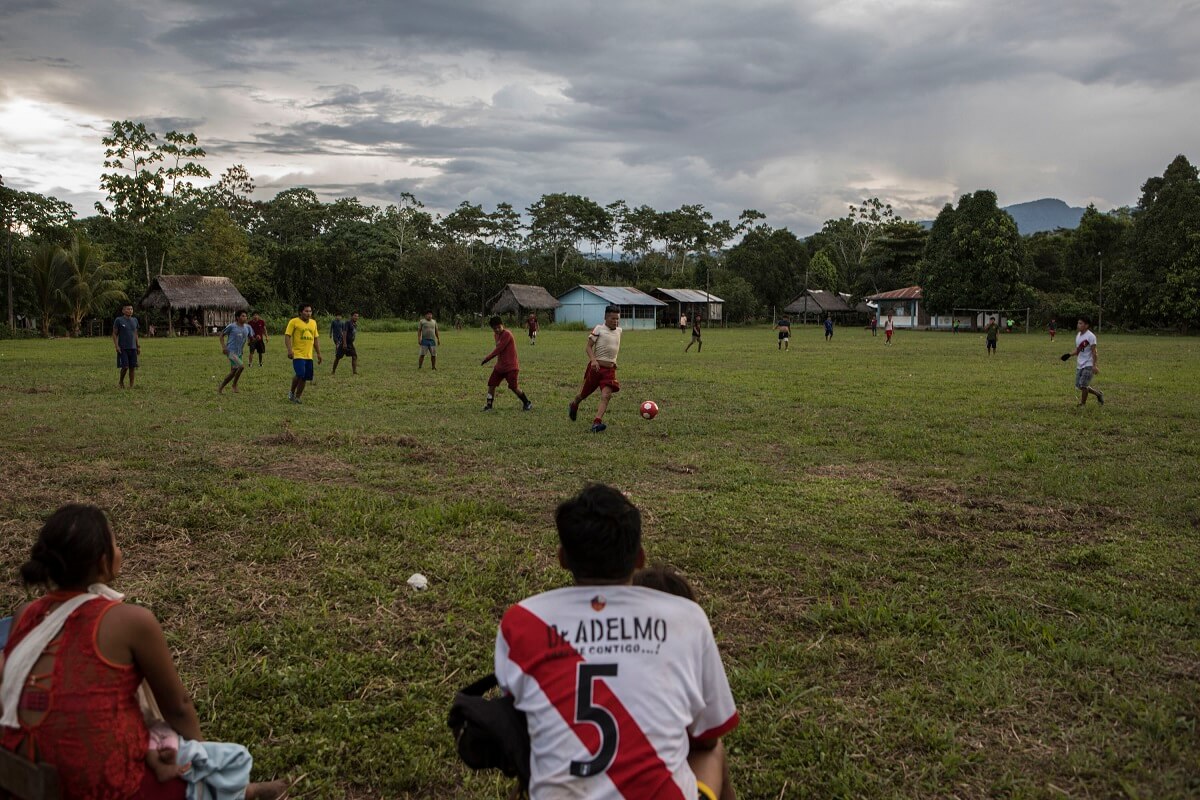
ENCOUNTER. At the center of their territories, Diobamba members have a football field to practice this sport in community.
Photo: OjoPúblico / Marco Garro
This response emphasized that the sector was in charge of the “most important” initiative on titling, called the Cadaster, Titling and Rural Land Registry Project in Peru (PTRT3), whose main objective is to formalize rural property in the forest and targeted areas of the Peruvian mountain range. However, in mid-October, delays in this program generated a sit-in of indigenous leaders in front of the Ministry of Justice and Human Rights in Lima.
James Leslie, UNDP technical advisor for ecosystems and climate change, indicated through the press area of the technical agency that according to the project in Peru, the titling of the DCI-UNDP program for the first and second stages, reached 450,000 hectares and that the agricultural directorates of the regional governments should have a larger budget for the community titling processes. "There are still gaps in the equipment needed to carry out the titling processes," said the specialist via email.
Leslie also indicated that the implementation of projects provides capacities such as logistics and human resources for field work but that the issuance of titles "depended entirely on the Regional Directorate of Agriculture''. When consulted for the small progress in titling communities in Ucayali, the expert recalled the detention in 2018 of DRAU officials and that in subsequent years, in addition to the health emergency, they were aware of "difficulties in consolidating their area of native communities". .
Files in a limbo
During the meeting held between OjoPúblico and the Diobamba's board of directors, the leaders recalled the fiscal episode involving the highest agricultural authority, Isaac Huaman Perez. This fact, unrelated to the activities they develop as a community, marked the delay in the expansion of 165 hectares of land that today would allow them to generate income from the commercialization of timber.
— [In the Agriculture Directorate of Ucayali] we are told that our documents are still in the public prosecutor's office and without them we cannot move forward_, Jarvi Tamani Lopez, the head of the community, complains as he opens a map of Diobamba and points his index finger at the new limits they would have if their extension were approved.
By the end of 2018, a seizure of Colonel Portillo criminal prosecution to DRAU collected a series of files that were pending by the then Director of Agriculture, Isaac Huaman Pérez and today with house imprisonment. Among the legal files seized, they found those of the communities of Diobamba, Quempitiari, Nueva Esperanza de Tabacoa, and Santa Clara de Uchunya. Since 2015, Santa Clara de Uchunya has been denouncing the forest in territories which they demands as their own and are used today for the cultivation of palm oil.
The case of Diobamba, which was named after the singing of toucans while flying, as reported by its members, is an example of the management in the titling and expansion of indigenous territories in charge of the agriculture management of Ucayali. In this office, a group of former authorities including Huaman Perez is investigated by the Lima Organized Crime Prosecutor's Office for land trafficking in this Amazon region.
Jarvi Tamani Lopez told OjoPúblico that to date no regional official had informed him of any progress in the process of expanding their territories. The lack of telephone and Internet signal, electrical system, and the budget required to travel to the city have also prevented Tamani López from following up on the paperwork.
"A year ago, I went to Pucallpa [capital of Ucayali] and in the Directorate of Agriculture I was told that they were going to ask the prosecution for information to start again [to resume processing] and they would call us when the titling is ready. However, when the pandemic came, everything was delayed. Now we have no resources to go," recalls Tamani Lopez after showing the plan showing the proposal to expand their territories.
Despite not being involved in the criminal investigation, the Diobamba file has not returned to DRAU offices. OjoPúblico learned that since 2019, no advances have been made for community-related documents to return to the regional management. Fiscal sources in the case told OjoPúblico that the seizure of documents should not delay administrative processes to grant titles to indigenous communities.
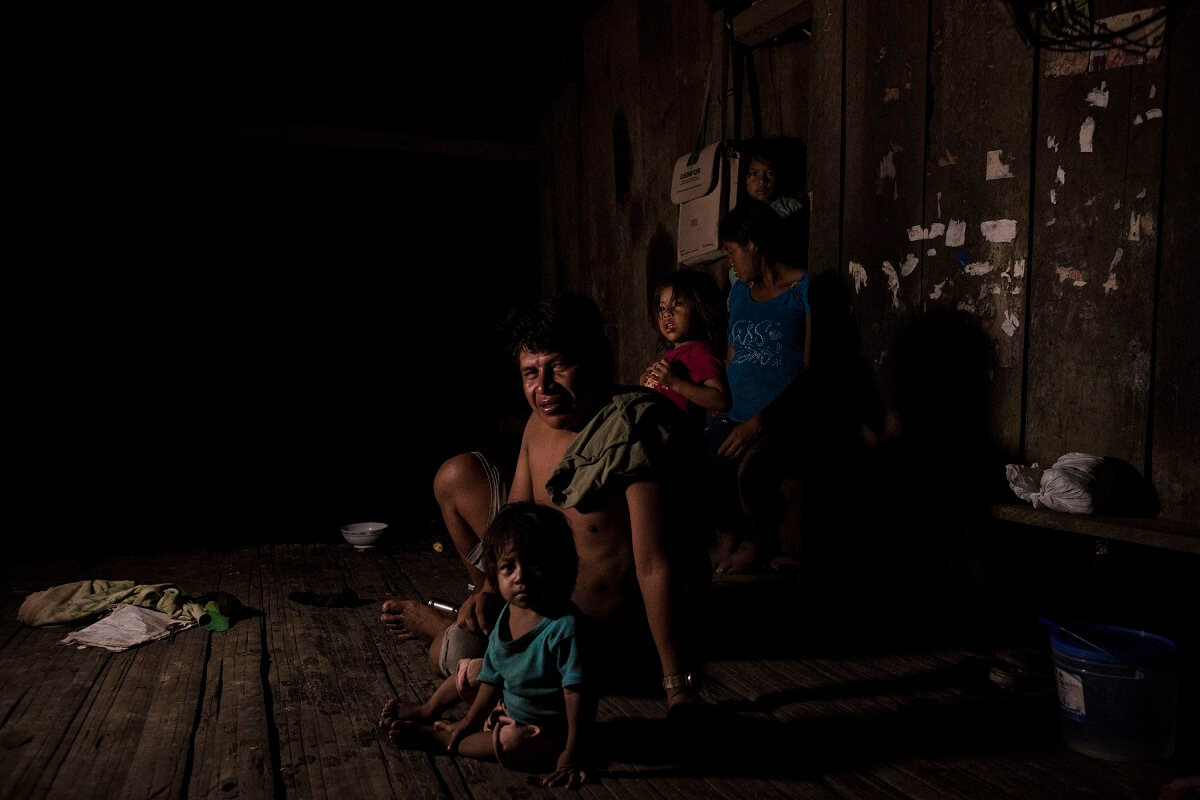
SUPPORT. Diobamba President, Jarvi Tamani Lopez, leads the call for expansion of his community. However, the lack of resources for transport prevents him from tracking the process.
Photo: OjoPúblico / Marco Garro.
When consulted on the delay in the Diobamba file, the director of Legal Physical Sanitation of the Ucayali Agrarian Property, Gino Castagle Rios, told this media outlet that the request for expansion was in the last stage and had a “cabinet process” completed in the field, but could not move forward because the documents had not returned to the agricultural management yet. Castagle Rios also stated that he was unaware of “the prosecutor’s office behavior”, but that his management undertook to carry out “the corresponding consultation and request [of the file]”.
According to information submitted by the Diobamba leaders to OjoPúblico, in October 2018, the Regional Directorate of Agriculture approved the territorial demarcation plan of this Asheninka community and only the titling decision to be registered at the Office of Public Registry was pending. It did not reach the last instance despite having started the process more than three years ago.
Pedro Tipula, a geographer and researcher at the Common Good Institute (IBC), indicated that the responsibility for this process lay with DRAU officials because the approval of the territorial demarcation was in a “99% near-final stage” in the extension process. “Certainly, when you have the perimetrical plan, all the verification stages have already been through to see if there is overlapping, properties, or previous acquired rights. Then, with that approval this stage shouldn’t be delayed. It is a matter of bureaucratic processing,” he explained.
In turn, the former Minister of the Environment, Gabriel Quijandria Acosta, recalls that regional governments play a major role in granting titles to indigenous communities and from this sector priority must be given to advancing these processes to "ensure a major effect on reducing deforestation" and "payments for results" can be received within the framework of the JDI.
Quijandria Acosta also questions whether regional agriculture authorities are in charge of community titling because “by not having a standardized view we have 26 ways to see titling processes and this has also become a source of corruption by regional governments, including titles related to indigenous territories,” he indicates.
Regarding the advance of the titling processes of indigenous communities, Quijandria Acosta also suggests watching the categorization of forests because they are in a "legal limbo" and represent "areas in which deforestation occurs more intensely".
Delayed expenses and activities
The Joint Declaration of Intent (JDI) was entered by the governments of Peru, Norway, and Germany on September 23, 2014. And by the end of May, Francisco Sagasti’s government approved an addendum that extended the first two of the three phases of the JDI until 2023. In this new phase, the UK government and the US agency USAID were added as observers of the process.
To carry out these activities, divided into three stages, the Norwegian government agreed to disburse around USD 300 million to be paid as results of the program were achieved. The third and last phase of such program has not yet been implemented, although it was originally planned to occur by 2020. In Peru, the responsibility for complying with the agreement lies with the Ministry of the Environment through the Directorate General for Climate Change and Desertification. What progress has been made to date?
Between 2016 and 2021, more than USD 16.5 million were executed according to figures reported by the United Nations Development Program (UNDP), which manages funds in Peru. These expenditures have been incurred in the first and second phases, the main tasks of which have focused on the adoption of standards aligned with the reduction of emissions from deforestation and forest degradation.
If expenditure items are reviewed, the largest amount is payments for consultants and contractual services. This group includes the local professionals and technicians who have implemented the program activities, such as field work for the processes of certification or expansion of indigenous territories. In the period under review, this concept represented 61.7% of total expenditure (over USD 9.2 million).
The next two items were travel (7.4%) and training, workshops, and conferences (6.6%), all related to the implementation of project activities. In a last block, there are some twenty disbursements (24.1%) corresponding to administrative expenses such as purchasing communication equipment, furniture, rental of premises, among others.
These disbursements respond to the program activities and objectives. Although UNDP was the administrator, the institution responsible for implementation was the Ministry of the Environment, which in turn coordinated with other sectors such as the Ministry of Agriculture or the regional governments of the Amazon included in the JDI.
Lucia Ruiz Ostoic, former Minister of the Environment, said that it was complicated for all levels of government to align in order to conduct the agreement activities, but that identifying the guiding objectives and parameters had to be clear. “We cannot talk of separate projects, but of comprehensive territorial views. There is a role that regional governments play in knowing whether progress is being made in this fight against deforestation,” she explained.
OjoPúblico also consulted, through the Transparency Act, on Minam’s coordination with San Martin and Ucayali regional governments within the JDI framework, but, without further detail in her response, the sector indicated that there was only a “letter of intent” to develop JDI activities. The Ministry also failed to provide detailed budget execution and indicated that this information was managed by UNDP.
Colombia: Indigenous communities want to get more involved
In Colombia, collective territories are indispensable for forest management: by 2018, they contained 53.4% of the country's natural forests, of which 46.1% correspond to indigenous resguardos and 7.3% to collective territories of black or Afro-Colombian communities, according to a report from the Ministry of the Environment and the Institute of Hydrology, Meteorology and Environmental Studies (IDEAM). Of the total of these indigenous shelters, 81% are found in the Amazon and Orinoquia regions in the southeast of the country.
Between 2000 and 2018, deforestation in the country affected more than 358 hectares in indigenous resguardos, 13% of the national total (2,678,195 hectares), according to the most recent report (2020) of the National Planning Department. It is not surprising, therefore, that the Joint Declaration of Intent in the country focuses much of its attention on strengthening indigenous peoples' capacities for forest conservation.
The agreement, entered by Germany, Norway, and the United Kingdom with Colombia at COP 21 in Paris in 2015, was renewed in Spain, during COP 25 in 2019, with a work framework throughout 2025. It works by pay-for-results financing (donors spend money after meeting the targets) in two different modalities: the first focusing on policy implementation, and the second on reducing emissions from deforestation.
The protective role of indigenous peoples is fundamental to achieving both objectives, and the agreement emphasizes that these groups “will have the chance to participate fully and effectively in program planning and implementation”.
In Colombia, two agencies have the greatest responsibility for the implementation of JDI-oriented objectives: Colombia Sostenible Fund, whose resources are administered by the Inter-American Development Bank (IADB), through a Technical Unit, and Vision Amazonia, a MinAmbiente program, whose resources are administered by the German development bank Kreditanstalt fur Wiederaufbau (KfW).
.
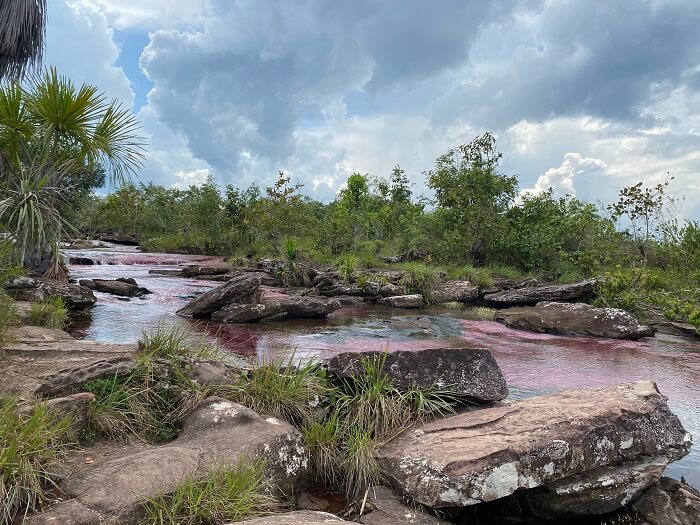
PROTECTION. The JDI in Colombia was renewed until 2025 to widen the impact of strategies to mitigate climate change.
Photo: Visión Amazonía.
Although the total amounts disbursed for the 2015-2020 agreement are not clear (at the close of this text OjoPúblico had not received the expense reports from MinAmbiente they had requested since October 18), to renew the Declaration, European countries agreed to disburse up to USD 366 million, resources that Colombia would be able to access once it meets the goals and milestones agreed in 2019. Of this amount, USD 51 million will be earmarked for achieving targets and USD 260 million for reducing emissions.
How does the management of these resources involve Colombian indigenous communities? At JDI 2015-2020, Colombia committed itself to “different capacity-building actions directed at indigenous, Afro-descendant and peasant organizations”. JDI 2020-2025 expands the scope of the benefit, stating that by 2022, “a proposal to implement payment schemes for environmental services and other incentives for conservation, aimed at indigenous peoples and Afro-Colombian communities, will have been formulated. The approach will be with the communities and will be in the implementation phase”.
However, at the same time, ONIC follow-up reports reveal that the picture for indigenous communities is not as encouraging.
.
Colombia Sostenible Fund: the delay in ethnic strengthening
Because of their relevance to forest conservation, implementing plans related to indigenous communities should be consistent. However, the Ethnical Group Capacity Building to Reduce Deforestation and Improve Forest Management project, proposed by the Colombia Sostenible Fund (FSC) and key to this process, took more than three years to be approved.
Based on information from the Inter-American Development Bank, provided by FCS to OjoPúblico, as of December 31, 2020, the FCS received a total of USD 35.6 million in donor contributions, of which 7% was spent in administration and execution expenses (overhead for implementing agencies) on 2018 and 2019 projects.
Of these resources, USD 29.8 million was committed to the 2018 and 2019 Annual Operational Plan (POA) projects. According to the POA Implementation Summary for these years, an amount of USD 4.8 million was proposed for strengthening ethnic groups (16% of the total budgeted for that period). It is the largest item, compared to the remaining 16 projects.
The proposed distribution of resources shows that actions to stop deforestation and control forests are priorities over capacity-building programs.
To date, however, the project has not recorded compliance disbursements due to the delay in its approval. Andrés Salazar, FCS Planning and Monitoring Specialist, explained to OjoPúblico that although the project was pre-formulated since the donation rounds of 2018-2019, its approval was signed only in November 2021, after the necessary adjustments for operation, so it is close to being executed.
Although the project was present in 2018 and 2019 donation rounds, subsequent operational plans show that it disappeared for the next two years.
According to the 2021-2022 Multiannual Plan, the amount available for investment in 2020 was USD 10.3 million, used for 8 projects, while 2 projects would remain in the formulation and approval phase. They were planned to be approved in 2021 for an amount of USD 6.6 million. The last two projects are: capacity-building of ethnic groups to reduce deforestation and improvement of forest management and the promotion of the forest economy to support the fight against deforestation.
However, in the FSC 2021 Action Plan, the capacity-building of ethnic groups program disappears again, and the component linked to indigenous communities is represented as part of the Ecological Restoration program, executed by MinAmbiente. “The projects not prioritized in the 2021 PAA have qualities similar to those presented, and therefore met the eligibility criteria. However, since there is no budget availability for 2021 PAA, these will be part of the 2022 PAA”, indicates the document sent by the FCS to OjoPúblico.
In fact, the FSC Multiannual Plan 2021-2022 takes over the project after two years. “Eighty-five topics suggested by the participants were received to be considered and contrasted in the FSC planning and management tools, of which 27 were carried out by the ethnic groups. The most important proposals are related to the inclusion of ethnic territories in the investment line 1.5, recognizing them as designers and implementers of public policies,” as indicated by the document.
The ethnic component is not unique to the strengthening project, so although it was approved only this year, FCS has continued to implement programs related to indigenous communities. As part of other JDI-oriented objectives, the Colombia Sostenible Fund will initiate restoration processes in 2022 on 200,000 hectares in high-deforestation areas, including land located in ethnic groups collective territories; and will establish occupation, use and tenure strategies for eight key protected areas in Colombia.
Visión Amazonía: strengthening to mitigate the crisis
REM Vision Amazonia is a Colombian government initiative to reduce emissions from deforestation. To this end, it seeks to establish a sustainable, low-carbon development model for the Amazon region for a better use of land and other natural resources. After signing of the Joint Declaration of Intent, the body became one of the implementers of the agreement.
The First Milestone Compliance Report under Modality 1 (2021), issued by MinAmbiente, details that 139 indigenous community projects have benefited through Vision Amazonia, as part of the Environmental Governance Pillar (one of the six pillars of the program). This pillar concentrates 22% of the total budget resources, and between July 2016 and June 2019, Vision Amazonia had planned and approved USD 60.7 million, out of a total of USD 85 million that donors plan to disburse for emission reduction until 2021.
All projects have been proposed and implemented by indigenous organizations, according to Eduardo Ariza, the pillar's leading anthropologist. Most programs have focused on capacity building, governance, food sovereignty, land-use planning, language, and traditions.
Vision Amazonia also participated, during 2020 and until March 2021, in technical advisory to municipalities concentrating the highest levels of deforestation, to incorporate the guidelines developed by the Ministry of Environment and Sustainable Development in the process of reviewing and adjusting its territorial planning plans.
Although less than 10, in Amazonas, Putumayo and Guainia, explicitly propose strategies for climate change mitigation; more such projects are implemented through the other pillars. All together, they intend to contribute to the reduction of deforestation and, therefore, the emissions they cause, explained to OjoPúblico José Yunis, EMN program director. “Defeating deforestation is complex. Vision Amazonía's responds from many fronts, articulating policies to strengthen forest protection,” he explains. He claims that empowering these communities has an impact on the territory and, therefore, on the fulfillment of objectives. He also claims that in communities intervened, deforestation remains the same or decreases, but does not increase.
Ariza agrees with Yunis, noting that one of the aspects that has most influenced forest protection is land tenure. “These areas [controlled by ethnic groups] have the least deforestation. That is why resources are geared towards the environmental governance mechanisms they have and the life systems they manage,” he adds.
In this regard, the ONIC follow-up report published in 2020 states: “we welcome these steps in the implementation of field programs and projects with indigenous and peasant organizations. However, the percentage of investment reported, of 21%, is low compared to 79% for the creation of related conditions and policies. It shows an unbalance that needs to be leveled.”
Dissatisfied ethnic groups
Reports of achievement of the objectives of the Joint Declaration of Intent (published by MinAmbiente) related to ethnic groups differ from reports of indigenous communities.
Colombia Sostenible Fund POA 2019 notes, for example, that “ethnic groups in the REDD+ preparation process (carried out in the 2015-2018 period), identified some possible solutions. These were included in the Integrated Strategy for Forest Deforestation and Management document”.
However, the first Indigenous National Organization Follow-up Bulletin to the Joint Declaration of Intent, published in February 2019, reports flaws that contrast with this statement, and also questions the evolution of measures to curb deforestation.
According to the ONIC, “while the Colombian government was announcing a 80% compliance with the JDI milestones and with that a frontal fight against deforestation, the Colombian branch of the Judiciary leading the Civil Chamber of the Supreme Court of Justice ruled in its judgment STC4360-2018 of April 5, 2018, that the phenomenon far from attenuating has strengthened in regions such as the Colombian Amazon. due to serious weaknesses in public policies and proposed strategies”.
They also claim that between 2016 and 2017 only two seminars were held on forest cover monitoring, where a representation of only two organizations participated, as assistants and not as panelists; and that the call was limited to publication on the website of the Colombian Environmental Information System; that despite their use of regular channels they are not heard, and that the mechanism for petitions, claims and complaints is not of immediate response and is virtual. For this reason, many communities have no access to it; and while some calls allow indigenous communities to be nominated, they are “restrictive and exclusive,” so ethnic groups have no real access to resource management and implementation.
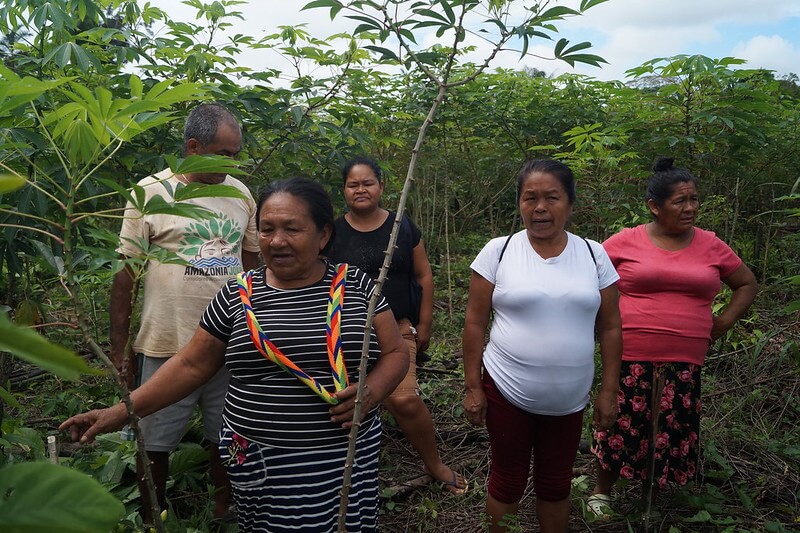
PROTAGONISM. More than a third of the projects implemented by Vision Amazonia are led by indigenous women.
Photo: Visión Amazonía.
The ONIC attributes these inconsistencies to the fact that “government classify compliance ratings on the valuation of some activities implemented rather than a direct weight of their actual environmental impact,” and calls on the international community to review, clarify, and modify some commitments made. OjoPúblico tried to contact, with no success, representatives of the ONIC to verify whether his accusation was addressed.
The same report also highlights flaws in the formalization of land tenure, and states that, to date, the collective titling of 2.6 million hectares was pending. “To date, only 44 resguardos have been formalized for indigenous peoples, and nearly 1,200 applications are in line at the national level,” the report mentions.
Gabriel Muyuy Jacanamejoy, Technical Secretary of the Fund for the Development of Indigenous Peoples of Latin America and the Caribbean (FILAC), believes that these differences between the reports are due to the fact that the national government invests more money in administrative expenses than in measures leading to a tangible environmental impact. “More than statements, we need action, too many resources are invested only in planning,” said the former vice-president of the ONIC to OjoPúblico.
For Muyuy, the environmental impact of JDI is only possible “with political will and correct decisions”, accompanied by “pedagogy and socialization of documents involving indigenous peoples”.
The indigenous leader, with a degree in Philosophy and Theology, also declares that the involvement of ethnic groups in forest conservation must include respect for their territorial rights and the promotion of inter-scientific dialog based on the recognition of their millennial knowledge. “Indigenous peoples go through many difficulties in guaranteeing their individual and collective rights. If their rights are not guaranteed and no articulated work is done between the public and the private sector, and indigenous and non-indigenous communities, there will be no real
environmental impact,” he indicates.
In view of Muyuy statement, Eduardo Ariza, leader of Vision Amazonia indigenous pillar, emphasizes that from the organization money is invested in precise and forceful actions that contribute to the conservation of the environment “in the entire Amazon biome, not only in the area of deforestation”, and not just in planning and training.
Despite this claim, the dissatisfaction of the indigenous community remains latent. In its 2020 report, the ONIC again found major flaws. “There is still a lag in guaranteeing the legal security of ancestral territories. The legal protection procedure for indigenous territories has not operated. There is an immense delay in the creation of indigenous resguardos. The paperwork in this regard is slow and cumbersome, with procedures not covered by the law,” the document emphasizes.
This statement also ensures that “the application of the mechanism of prior, free, and informed consultation and consent, as the fundamental right of ancestral peoples, leaves much to be desired in meeting the commitments, but above all in the little respect shown towards the dialog with diverse cultures”.
The National Organization of Indigenous Peoples from the Colombian Amazon (OPIAC), in turn, also declared in September 2021 in view of the silence of the national government in recognizing their rights and the exclusion of those who claim to be victims: “The Colombian government has repeatedly denied openly the real, active and effective participation of the Amazon Indigenous peoples in decisions concerning our territory,” they claim, and quote as an example the discussion and approval of the Leticia Pact, framed among the achievements of the JDI.
In the midst of reports, budgets, addenda, and climate financing activities, the work of indigenous communities, who from their territories — in many cases with the use of their ancestral knowledge — should not be lost as they have a key mission in forest care to mitigate the effects of the climate crisis.
 Tienes reportajes guardados
Tienes reportajes guardados






